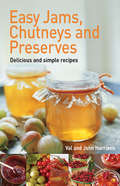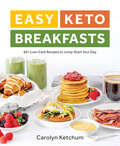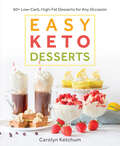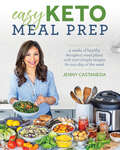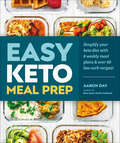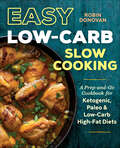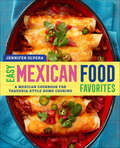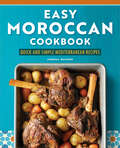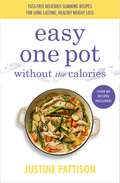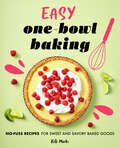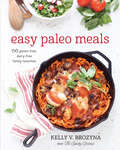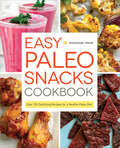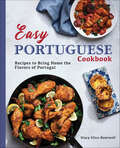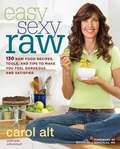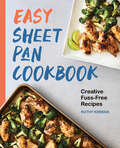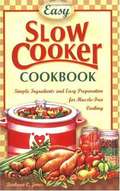- Table View
- List View
Easy Jams, Chutneys and Preserves
by John Harrison Val HarrisonThis book explains all you need to know to make your own delicious jams, jellies, marmalades, fruit butters, fruit cheeses, chutneys and pickles, including details of all the necessary equipment, how to choose the best fruit and vegetables to use, and how to make sure the jam sets properly to produce the best results.In these straitened times, more and more people are keen to save money by making jams, jellies and chutneys from the surplus of their own homegrown fruit and vegetables or from free fruit, such as blackberries, available in nearby hedgerows. Val and John Harrison show how easy it is to collect together the required ingredients and start making your own produce.
Easy Keto Breakfasts: 60+ Low-carb Recipes To Jump-start Your Day
by Carolyn KetchumGo beyond bacon and eggs and step back into the creative kitchen of renowned food blogger and author Carolyn Ketchum as she shows you how to make the most of your mornings with her most sought after a.m. recipes! Easy Keto Breakfasts is an assortment of delectable low-carb, time- saving recipes that will leaving you feeling satisfied and ready to take on the day. Easy Keto Breakfasts delivers an assortment of those can’t live without baked goods that Carolyn is famous for including: Maple Pecan Scones, Strawberry Skillet Breakfast Cake and Macadamia Coconut Granola while also bringing new twists to the time-tested favorites such as omelets and breakfast meats. Carolyn meticulously presents over 50 keto recipes that are so easy-to-follow and feature full color photos, nutrition information, along with make-ahead and time saving tips that will change your life!
Easy Keto Desserts
by Carolyn KetchumDessert lovers, rejoice! Yes, on a healthy ketogenic diet, you can have your cake and eat it, too. In Easy Keto Desserts, bestselling author Carolyn Ketchum shows you how to enjoy the sweet side of keto with a variety of delectable dessert recipes. She brings her considerable expertise in low-carb, grain-free baking to this book and invites you to indulge—healthfully. We live in a sugar-filled world, and temptation is all around us. Birthday parties, holidays, and the office break room are veritable minefields of sugar and excess carbohydrates. No one wants to feel deprived, and Easy Keto Desserts proves that you don’t have to. This collection of low-carb, high-fat sweet treats will help you resist the siren call of sugar without sacrificing flavor or texture. Don’t be surprised if you find that you don’t want to share! Easy Keto Desserts includes more than 50 easy-to-make recipes along with full-color photos, detailed instructions, and helpful tips for spectacular results. Oh, how sweet it is.
Easy Keto Diet for Beginners: A Complete Guide to Kick-Start the Ketogenic Lifestyle
by Frank CampanellaReach ketosis and start losing weight the easy wayThe keto diet is a tried-and-true method for getting real weight loss results, but it can be intimidating to get started. This keto diet meal plan for beginnerssimplifies the process, with a brief introduction to the diet and easy recipes for anyone looking to make the change. Learn how to whip up healthy meals with step-by-step guidance, supportive tips and tricks, and handy background information to help you shed the pounds and keep them off.Inside this keto diet cookbook, you'll find:Keto 101—Learn the science behind the ketogenic diet and how it works with an easy-to-digest introduction.Simple and comprehensive recipes—Discover tasty, easy recipes that include crucial macronutrient information, so you can get the full keto profile at a glance.Guided meal plans—Stick to your keto journey with meal prep and make a whole week's worth of food at once.Drop the pounds with the beginner-friendly and cravable recipes in this keto cookbook.
Easy Keto Dinners
by Carolyn KetchumModern life may be fast-paced and furious, but everyone needs a healthy and delicious home-cooked meal. From her hundreds of thousands of social media followers and website visitors, low carb food blogger Carolyn Ketchum hears the same question time and again: Is this recipe easy to make? With this book, Carolyn invites readers into her kitchen, this time to deliver mouthwatering keto dinners that are quick and simple to prepare. In Easy Keto Dinners, Carolyn has put together a collection of flavorful weeknight meals that take minimal effort. Consider it a manual for making keto dinners the whole family will savor—all in less time than it would take to pick up takeout. As always, Carolyn knows that taste comes first, even for home cooks with dietary restrictions, so the focus is on making low carb, high-fat meals that rival their non-keto counterparts. Easy Keto Dinners includes more than 50 recipes for effortless meals, complete with full-color photos, detailed prep instructions, and helpful tips to streamline the dinner process.
Easy Keto Meal Prep
by Jenny CastanedaEasy Keto Meal Prep is a comprehensive four-week meal preparation guide that takes the guesswork out of ketogenic eating by providing an easy-to-follow template for weekly meal planning. Each menu features delicious low-carb, keto-friendly meals that will get you off and running to success on today’s most popular diet! Author Jenny Castaneda is the creator of the popular blog and healthy living site Cook and Savor. Jenny’s plan is designed to accommodate the demands of real life. She teaches you how to minimize your time in the kitchen by preparing your meals on one or two days so you have five days’ worth of food for breakfasts, lunches, and dinners! The other meals of the week are “free meals” for eating out, attending work lunches, and using leftovers. The done-for-you meal plans in Easy Keto Meal Prep mean you don't have to think about what to eat or what to shop for, or how to plan your prep and cook days. After you’ve given them all a try, you’ll be ready to mix and match the recipes (and add your own) to come up with do-it-yourself plans! Sample Recipes Include: Blender Pancakes Goat Cheese and Salmon Spread Wonton Noodle Soup Italian Casserole Sheet Pan Beef Kabobs Crispy Carnitas Five-Spice Meatballs Mediterranean Couscous Turmeric Garlic Cauliflower Rice No-Bake Blueberry Cheesecake Cups Whether you are new to the keto diet or you are a keto veteran, Easy Keto Meal Prep is a fantastic resource for staying healthy, happy, and on point living a keto life!
Easy Keto Meal Prep: Simplify Your Keto Diet with 8 Weekly Meal Plans and 60 Delicious Recipes
by Aaron DayTake the guesswork out of keto meal prep planning with over 60 low-carb recipes and 8 easy-to-follow weekly meal plans! Eating keto can be challenging, and cooking keto recipes that are satisfying can be even more challenging! You need to make sure you're eating enough fat to stay in ketosis, while still eating food that is satisfying. Weekly meal prep can help ensure that you stay in ketosis while still enjoying fresh, delicious, keto-friendly recipes that aren't the same every week. With Easy Keto Meal Prep, planning and preparing your weekly keto meals has never been easier! Dive straight in to discover:- 8 weekly meal plans, each with a detailed step-by-step prep plan, shopping list, and equipment list, and each with four main recipes and four alternative recipes that can be swapped in - Over 60 delicious recipes, each with specific macros and detailed nutrition information to ensure you're always eating the right ratios to stay in ketosis- Beautiful photography and visual meal grids that show you exactly what you'll be eating each day, along with the macros ratios for each day's meals - Helpful guidance for eating keto, sticking with the diet, meal prepping like a pro, and safely storing your prepped meals Each recipe in this low-carb cookbook includes specific macro ratios and detailed nutrition information to ensure you're always eating the right ratios to stay in ketosis. With over 60 delicious recipes, you'll enjoy a large variety of keto meals sure to burn fat and give you a metabolism boost like never before! Featuring 8 weekly meal plans to offer a broad range of recipe combinations, this keto cookbook will ensure you'll never have to eat the same week of meals twice, and each prep plan includes detailed shopping lists, step-by-step prep day instructions, and handy equipment lists to help you prepare a week&’s worth of meals in just a few hours! Also included in this ketogenic diet book is helpful guidance for eating keto and sticking with your diet, tips on how to meal prep like a pro, and safely store your prepped meals. Fancy adopting a keto diet this New Year? Then this is definitely the book for you!
Easy Keto in 30 Minutes: More than 100 Ketogenic Recipes from Around the World
by Urvashi PitreAll-new easy keto recipes from the author of the best-selling The Keto Instant Pot Cookbook Interest in the keto and low-carb diet continues to sweep the country as people are finally achieving weight loss success, and keeping the weight off, but it can still be difficult to find recipes easy enough to get on the dinner table after a long day at work. Urvashi Pitre, author of the best-selling The Keto Instant Pot Cookbook, who lost an incredible 80 pounds following a low-carb, keto diet, understands the struggles well. She has raised two sons and she runs her own company, so she knows how hard it can be to keep on track with healthy cooking night after night. She also knows that it's nearly impossible to stick to a diet plan if the recipes don't taste great. Urvashi has become famous for her delicious and impeccably tested recipes, and this book will deliver the same with flavor-packed dishes like Broccoli Cheddar Soup, Chicken Sate with Peanut Sauce, Beef Enchilada Casserole, and even desserts like Lemon Pound Cake to satisfy your sweet tooth, all ready in 30 minutes or less.
Easy Ketogenic Diet Slow Cooking: Low-Carb, High-Fat Keto Recipes That Cook Themselves
by Amy RamosThe convenience of slow cooking meets your favorite keto flavors. People who've turned to the ketogenic diet often have tremendous success losing weight. But in order to keep losing weight—and avoid putting it back on—you need to have a long-term commitment to the diet. Easy Ketogenic Diet Slow Cooking shows you how to combine simple keto-compliant ingredients in scrumptious slow cooking recipes to create a weight loss regimen you'll be happy to follow. This is the first slow cooker cookbook specifically for the ketogenic diet—and it brings you delicious recipes that require no fancy ingredients. So you can enjoy familiar flavors, affordable meals, and the hands-off convenience of slow cooking. Easy Ketogenic Diet Slow Cooking includes: 120 ketogenic diet compliant recipes—Stay true to your weight loss guidelines and savor substitution tips. Simple, affordable meals—Recipes use easy-to-find ingredients to create meals you already know and love. "Fix-and-Forget" convenience—Easy prep, effortless cooking—these slow cooking recipes practically do the work for you. Nothing feels better than losing weight and keeping it off. It's time to give your ketogenic diet the slow cooking advantage.
Easy Livin' Microwave Cooking
by Karen Kangas DwyerThis microwave primer will show you why you bought a microwave oven in the first place: to save time, money and energy at every meal, every day. Karen Dwyer has created more than 200 recipes that require minimal preparation and commonly available ingredients to make great-tasting: appetizers, fish, meat, and poultry, dishes, casseroles, breakfast foods, vegetables and fruits, candies and desserts, and more. Designed with beginnings cooks in mind, the book features microwave cooking time charts for various foods, a simple explanation of how the microwave ovens. With dozens of tips on making the most of your microwave oven, Easy Livin' helps anyone prepare attractive, satisfying family meals in minutes instead of hours.
Easy Low-Carb Slow Cooking: A Prep-and-Go Cookbook for Ketogenic, Paleo & Low-Carb High-Fat Diets
by Robin DonovanFinally, a Low Carb Cookbook with Prep-and-Go Recipes for Healthy LivingLow-carb diets are more popular than ever. Limiting refined carbohydrates and increasing healthy fats and proteins can help you lose weight and improve cardiovascular health. Cooking your own meals is essential when trying to eat a low-carb diet, as dining out or buying prepared foods can make it difficult to adhere to a low-carb lifestyle.With this in mind, Robin Donovan, New York Times bestselling co-author of Dr. Gott's No Flour, No Sugar Diet, has created the ultimate low-carb cookbook. By using healthy, truly low-carb ingredients, Easy Low-Carb Slow Cooking is the only low carb cookbook that allows you to enjoy flavorful meals that are good for your waistline and your wallet. By gearing these recipes to the convenience and ease of the slow cooker, prep time and cleanup has never been simpler.More than 125 "prep-and-go" slow cooker recipes designed to make a low-carb, high fat diet easier than everTruly low-carb, high fat dishes that follow ketogenic dietary guidelines, as well as "Make It Paleo" substitution tipsDetailed nutritional information for each recipe, including macronutrient percentages for carbs, fat, and proteinEnjoy low carb cooking recipes such as: Frittata with Cherry Tomatoes, Asparagus & Thyme * Cinnamon Crunch Coffee Cake * Curried Broccoli, Cheddar & Toasted Almond Soup * Bacon-Wrapped Chicken with Barbecue Sauce * Thai Red Curry Beef with Coconut Sauce * Chocolate-Macadamia Nut Cheesecake * and more!
Easy Mexican Food Favorites: A Mexican Cookbook for Taqueria-Style Home Cooking
by Jennifer OlveraReal Mexican food. Real easy.Easy Mexican Food Favorites proves that you don't have to live south of the border to make amazing Mexican cuisine. From Spicy Shrimp Tacos to Pork Carnitas, this Mexican cookbook is filled with simple and sumptuous recipes that every home cook can master.Not much time to cook? Not a problem. This Mexican cookbook makes it easy to fit flavorful dishes into any schedule with make-ahead tips, timesavers, and lots of recipes that take 30 minutes or less.This easy Mexican cookbook includes:No-hassle recipes—From tacos to tamales, this Mexican cookbook is filled with 115 easy-to-follow recipes for classic favorites.Fast and flavorful—Discover a Mexican cookbook that saves cooking time with meals that are as quick as they are delicioso.Authentic flavors, familiar ingredients—Create real Mexican tastes using items you can find at your local grocery store.Find out how simple it is to spice up your meals with Easy Mexican Food Favorites.
Easy Moroccan Cookbook: Quick and Simple Mediterranean Recipes
by Aneesa WaheedCreate mouthwatering Moroccan cuisine at home Moroccan food is bursting with unique and vibrant flavor combinations—and now you can enjoy it from the comfort of your own kitchen! This cookbook makes Moroccan cooking easy, with all the beginner-friendly guidance and simple recipes you'll need for success. Moroccan cooking fundamentals—Get started with an overview of Moroccan cuisine and culture, and find tips for sourcing Moroccan staple ingredients. A variety of delicious dishes—Explore traditional cuisine from across the country's diverse regions and try creative dishes that use Moroccan flavors in exciting and inventive ways. Convenient recipe labels—Simplify mealtime with handy labels for 5-ingredient, one-pot, 30-minute, no-cook, vegan, and vegetarian dishes. Capture the flavors of Morocco—no matter your skill level—with the Easy Moroccan Cookbook.
Easy One Pot Without the Calories
by Justine PattisonPart of a brand new series of low calorie cookbooks devised by best-selling author and the UK's favourite diet recipe writer, Justine Pattison.ONE POT WITHOUT THE CALORIES takes all the hassle out of eating the low cal way. Justine's thoroughly tested recipes are simple, accesible and imaginative. Her writing experience and clever combinations will make losing weight as easy as 1-2-3! Each delicious one pot recipe is supplied with introductions, prep and cook times, calorie counts and additional applicable nutritional information, plus Justine's trademark tips and ideas to support and enhance the cooking experience!
Easy One Pot Without the Calories
by Justine PattisonONE POT WITHOUT THE CALORIES takes all the hassle out of eating the low cal way. Justine's thoroughly tested recipes are simple, accesible and imaginative. Her writing experience and clever combinations will make losing weight as easy as 1-2-3! Each delicious one pot recipe is supplied with introductions, prep and cook times, calorie counts and additional applicable nutritional information, plus Justine's trademark tips and ideas to support and enhance the cooking experience!
Easy One-Bowl Baking: No-Fuss Recipes for Sweet and Savory Baked Goods
by Kelli MarksDiscover how easy baking can be when all you need is one bowl There's nothing quite like fresh-from-the-oven goodness. With Easy One-Bowl Baking, scratch baking is just as simple as cracking open a mix, and twice as delicious! Save time without sacrificing flavor as you create everything from cookies and quick breads to cakes and savory bites. More than a dessert cookbook, this baking book makes it easy to bake indulgent Chocolate Chunk Pound Cake, delicate Matcha Cookies, or even crowd-pleasing Buffalo Chicken Breadsticks. Best of all, with just one bowl, one baking pan, and a few mixing and measuring tools, the sink won't be full of dishes when you're done, making cleanup a breeze! Baking 101—Learn all the essential ingredients, techniques, and terminology to bake like a pro in this easy baking cookbook. Quick fixes—Find 60 fast bakes, most able to go from mixing bowl to oven to cooling in under an hour. Kid friendly—Introduce young chefs to the joys of baking with recipes they can help measure, mix, and bake. Grab your favorite bowl, a wooden spoon, and this cookbook and start baking something special today.
Easy Oven Dishes: 100 Ways to a Wonderful Meal
by Rodale PressEasy Oven Dishes is chock full of superb oven-baked dishes that are easy to put together and bake on their own, so you can relax while dinner cooks. Expect to find many main-dish favorites, including chicken, pork, and beef--as well as plenty of delicious desserts and sides--all with wonderful down-home flavor, but faster than ever before.
Easy PCOS Diet Cookbook: Fuss-Free Recipes for Busy People on the Insulin Resistance Diet
by Tara SpencerThe easy way to take control of your PCOS symptoms—The Easy PCOS Diet Cookbook gives you fuss-free recipes to fight PCOS with an insulin resistance diet.Struggling with PCOS symptoms is already hard enough, but following an insulin resistance diet to alleviate them shouldn't be. That's why Tara Spencer, a nutritionist specializing in PCOS who suffers from the condition herself, created The Easy PCOS Diet Cookbook—to give busy PCOS fighters the easiest, most hassle-free recipes to eliminate symptoms. The Easy PCOS Diet Cookbook helps readers prepare super simple meals using 5-ingredient recipes—many of which require only 30-minutes or less to make or just one pot—so that they take control of PCOS without wasting any time.The Easy PCOS Diet Cookbook features:125 Easy Recipes providing a mix of 5-ingredient recipes, 30-minute recipes, one-pot recipes, one-pan recipes, and no-cook recipesEasy-to-Find Ingredients using affordable, and easily found items from any grocery storeEssential Info on PCOS teaching you need-to-know information about changing your lifestyle and diet to feel betterLiving with PCOS isn't easy, but changing your diet to manage symptoms can be with The Easy PCOS Diet Cookbook.
Easy Paleo Meals
by Kelly V. BrozynaAs a busy mom of three who has been feeding her family a restricted diet for multiple health reasons, Kelly understands the challenges of preparing healthy meals daily. Having nearly a decade of experience in gluten-free dairy-free cooking and baking, Kelly presents scores of creative meals using time saving-techniques essential to anyone wanting to make healthy eating easier. Also inside: How to maximize your results with efficient meal planning. Useful strategies for making the most of every ingredient. Several make-ahead dry mixes for all sorts of baked goods, including pizza & bread, pancakes & muffins, scones & pie crust, making for fast and easy weeknight baking. Tips and tricks for optimizing health and soothing stress. How to get your kitchen organized and save money.
Easy Paleo Snacks Cookbook: Over 125 Satisfying Recipes for a Healthy Paleo Diet
by Rockridge PressFrom the Publisher of New York Times Bestsellers Paleo Slow Cooker and Paleo for Every DayEasy Paleo Snacks Cookbook gives you more than 125 simple, inventive snacks that will satisfy your family and help you power through the day. With classic paleo snack recipes and special recipes for kids, athletes, protein, breakfast, parties, dessert, and people on the go, Easy Paleo Snacks Cookbook will round out your daily meals and make you excited about sticking to your healthy paleo diet.Let Easy Paleo Snacks Cookbook add delicious variety to your menu, with: 125+ paleo snack recipes including Banana Chocolate Chip Cookies, Cherry Chunk Bars, and Paleo Jambalaya 10 extremely easy recipes that take less than 5 minutes to make 16 easy swaps for harder-to-find ingredients 13 kid-friendly recipes to keep the kiddos happy Handy nutritional information, prep time, and cook time for each recipe With simple recipes and healthy ingredients, Easy Paleo Snacks Cookbook will broaden your culinary repertoire and make your paleo diet even more empowering.
Easy Portuguese Cookbook: Recipes to Bring Home the Flavors of Portugal
by Stacy Silva-BoutwellAuthentic Portuguese plates—no passport requiredIt doesn't matter if you're a novice cook or a seasoned chef—you can recreate the mouthwatering flavors of Portugal in the comfort of your own kitchen. The Easy Portuguese Cookbook makes it possible with a selection of simple and sumptuous recipes, as well as an essential primer for mastering the finer points of Portuguese cuisine.Whether it's snack-sized petiscos (small bites), a tasty bifana (pork cutlet sandwich), or carne guisada (beef stew), you'll find everything you need to prepare dozens of traditional Portuguese favorites—including helpful ingredient substitutions for when you just can't find good chouriço (smoked pork sausage). This complete Portuguese cookbook even helps you put a finishing touch on your meal plans with a brief look into Portuguese wines and pairing suggestions, regional specialties, and more.The Easy Portuguese Cookbook includes:75+ Classics made easy—This Portuguese cookbook features straightforward guidance and accessible recipes that make it a snap for cooks of all levels to prepare these delicious plates.A flavorful tour of Portugal—From Costa Verde to Algarve, discover a variety of dishes that will take you on a culinary journey across Portugal.Party planning—Share your love of food with the selection of sample menus inside this Portuguese cookbook that are perfect for family dinners, cocktail parties, and more.It's never been easier to get started cooking Portuguese food than with the Easy Portuguese Cookbook.
Easy Sausage Making: Essential Techniques and Recipes to Master Making Sausages at Home
by Will BudiamanThe missing link for new sausage makers.Discover the joys of creating your own sausages at home with Easy Sausage Making. Filled with essential information for first timers, this sausage making book takes you from selecting the right tools and picking the best cuts of meat to twisting off perfect links in no time.From Bratwurst and Beef Bangers to Spanish Chorizo and Vietnamese Shrimp Sausage, this simple guide is jam-packed with savory sausage recipes from around the world. Get cooking.Easy Sausage Making includes:Sausage making 101—Sausage types, essential meats, casing choices, proper tools…get all the info you need to start stuffing sausages.Fully illustrated instructions—Learn the basics of sausage making with the help of full-color photos that make it easy to follow along.75 delicious recipes—Craft dozens of different sausage, then find the best ways to serve them up for breakfasts, lunches, and dinners.Start making (and munching) sausages today with Easy Sausage Making.
Easy Sexy Raw: 130 Raw Food Recipes, Tools, and Tips to Make You Feel Gorgeous and Satisfied: A Cookbook
by Carol AltThe ultimate raw food book, for raw newbies and experienced raw foodists alike, with 130 recipes and shopping and swapping lists. Nearly twenty years ago, thanks to a raw food diet, Carol Alt cured a world of headaches, stomach issues, and fatigue and became healthier, more energetic, and slimmer than she's ever been. In Easy Sexy Raw she shares how anyone can experience the benefits of the uncooked lifestyle. Carol takes all of the intimidation out of going raw, providing straightforward advice, easy tips, and 130 super-simple and delicious recipes that will make the transition a snap. Useful tools--such as a swapping list of raw substitutes for favorite cooked items and a "Turn It Raw" section that shows you how to gradually convert favorite dishes to raw (even chocolate chip cookies!)--will help both new and seasoned raw eaters to build a recipe repertoire. And the dishes, including contributions by raw food authorities and chefs like Ani Phyo, Sarma Melngailis, and Raw Chef Dan, are tasty and filling--even for those who are just trying out raw for the first time: * Yellow Squash Fettuccine with Creamy Pine Nut Alfredo, Lemon Basil, and Green Olives * Good Stuff by Mom & Me's Salad Pizza with Tomato Sauce * Gingery Squash and Coconut Noodle Soup * Indian-Style Papaya Salad * Abundance Burgers with Marinated Mushrooms and Jícama Fries * Apple Marzipan Pie * Triple Orange Salad with Pistachios and Mint * Maya Chocolate Pie Carol offers tips on the best equipment to use; demystifies methods like soaking, sprouting, and dehydrating; and even discusses raw dairy, good and bad fats, and which sweeteners are best for your body.Easy Sexy Raw is the must-have primer for anyone who wants a healthier lifestyle and a natural way to feel sexier and more beautiful.
Easy Sheet Pan Cookbook: Creative, Fuss-Free Recipes
by Ruthy KirwanSimple, flavorful sheet pan meals for busy home cooks Are you often short on time at mealtime? Break out your sheet pan and the Easy Sheet Pan Cookbook! This creative cookbook is packed with quick and easy recipes that let you and your family enjoy a delicious, nourishing meal even on the busiest of days. The only cookware you'll need is your sheet pan, making prep and cleanup a breeze. Discover how sheet pan cooking brings out the best in meats and vegetables, tenderizing them while blending and amplifying their flavors. Get tips for buying and caring for sheet pans, and learn how you can use them to create complete meals—no matter your experience level. The Easy Sheet Pan Cookbook includes: Flavorful recipes—Savor a variety of satisfying vegetarian, seafood, poultry, and meat dishes, many created with internationally inspired flavors. 45 Minutes or less—Get meals on the table fast with recipes that take 45 minutes from start to finish—many ready in only half an hour. Make it your way—The handy labels in this sheet pan cookbook help you find quick-prep, 5-ingredient, and no-knife-necessary recipes. When you're running low on time or energy, these one pan meals let the oven do the work for you.
Easy Slow Cooker Cookbook
by Barbara C. JonesFrom the back cover Slow Cooking It Just Makes Life Easier Put your food inside a slow cooker, cover the pot, turn the switch to "on" and come home after hours of errands, soccer games, meetings, work or play and dinner is ready! Meals are simple, convenient and much better than fast food! These recipes are so easy anyone can cook them and they are so delicious everyone will love them. Try these family hits! Roasted Red Pepper Pork Tenderloin Cajun Bean Soup Unbelievable Crab Dip Bacon-Wrapped Chicken South-of-the-Border Beef Stew Magnificent Fudge Chocolate Fondue These are recipes that strengthen our families and bring us the satisfaction of being together for a homecooked meal.
